Forest Mist |
|
 |
 |
Knitted jacket with shawl collar, split in sides and diagonal shoulders. Sizes S - XXXL. The piece is worked in DROPS Alpaca Bouclé.
DROPS 184-17 |
|
|
INFORMATION FOR THE PATTERN: RIDGE/GARTER STITCH (worked back and forth): 1 ridge = Knit 2 rows. MEASURING TIP: Because of the weight of the yarn, take all length measurements when holding the piece up, or the garment will be too long when worn. DECREASE TIP (for sides): Decrease inside 1 edge stitch in garter stitch. All decreases are worked from the right side. Decrease as follows after the 1 edge stitch in garter stitch: Slip 1 stitch as if to knit, knit 1, pass the slipped stitch over (= 1 stitch decreased). Decrease as follows before the 1 edge stitch in garter stitch: Start 2 stitches before the edge stitch and knit 2 together (= 1 stitch decreased). INCREASE TIP (for sleeves): Increase 1 stitch inside the 1 edge stitch in garter stitch by making 1 yarn over. On the next row work the yarn over twisted to avoid a hole (the increased stitches are worked in stocking stitch). BUTTONHOLES: Work buttonholes on right band. 1 BUTTONHOLE = knit together 5th and 6th stitch from the edge (= in the transition between the 5 band stitches in garter stitch and the stocking stitch section) and make 1 yarn over. On the next round knit the yarn over to leave a hole. Work buttonholes when the piece measures: S: 49 and 59 cm M: 50 and 60 cm L: 51 and 61 cm XL: 52 and 62 cm XXL: 53 and 63 cm XXXL: 54 and 64 cm ---------------------------------------------------------- JACKET: The piece is worked back and forth with circular needle and is sewn together at the end. BACK PIECE: Cast on 110-116-124-132-140-150 stitches with circular needle size 5 mm and Alpaca Bouclé. Change to circular needle size 4 mm and work 2 RIDGES – see description above. Change back to circular needle size 5 mm. Work stocking stitch with 5 edge stitches in garter stitch in each side. REMEMBER THE KNITTING TENSION! When the piece measures 25 cm – read MEASURING TIP, cast on 1 stitch at the end of the next 2 rows (the split ends here) = 112-118-126-134-142-152 stitches. Continue working stocking stitch with 1 edge stitch in garter stitch in each side. When the piece measures 30 cm decrease 1 stitch in each side – read DECREASE TIP (= 2 stitches decreased). Repeat the decreases when the piece measures 50 cm = 108-114-122-130-138-148 stitches. When the piece measures 66-68-70-72-74-75 cm cast off 4-5-7-9-10-12 stitches at the beginning of the next 2 rows for the armholes = 100-104-108-112-118-124 stitches. Continue with stocking stitch and 1 edge stitch in garter stitch in each side towards the armholes. When the piece measures 82-85-88-91-94-96 cm, place stitches on a thread for the diagonal shoulders and cast off stitches for for the neck: Place stitches on a thread for the diagonal shoulders at the beginning of each row from the armhole as follows in each side (work the stitches before placing them on the thread): Place 11-12-13-14-15-16 stitches on the thread 2 times, then 19-19-18-18-18-19 stitches on the thread 1 time. When all stitches on the shoulder have been placed on the thread there are 18-18-20-20-22-22 stitches left for the neck in the middle of the back piece. Cast off these stitches for neck. All stitches have now been cast off/placed on the thread and the piece measures approx. 85-88-91-94-97-99 cm (measured from top of shoulder down). Place the stitches from the thread on the one shoulder back on circular needle size 5 mm. Knit 1 row from the wrong side – NOTE. To avoid holes in the transitions where stitches have been on the thread, pick up the loop between 2 stitches and knit it twisted together with the next stitch on the row. Cast off. To avoid a tight cast off edge you can cast off with a larger needle size. Repeat on the other shoulder. RIGHT FRONT PIECE: Cast on 73-76-82-86-92-97 stitches with circular needle size 5 mm and Alpaca Bouclé. Change to circular needle size 4 mm. Work 2 ridges. Change back to circular needle size 5 mm. Work stocking stitch with 5 edge stitches in garter stitch in each side (= 5 band stitches in garter stitch at the beginning of the row from the right side and 5 edge stitches in garter stitch at the end of the row in the side). When the piece measures 25 cm cast on 1 new stitch at the end of the row from the right side (the split ends here) = 74-77-83-87-93-98 stitches. Then work stocking stitch with 5 band stitches in garter stitch and 1 edge stitch in garter stitch in the side. When the piece measures 30 cm decrease 1 stitch in the side as for the back piece (= 1 stitch decreased). Repeat the decrease when the piece measures 50 cm = 72-75-81-85-91-96 stitches. REMEMBER BUTTONHOLES - see description above! When the piece measures 66-68-70-72-74-75 cm cast off 4-5-7-9-10-12 stitches at the start of the next row from the wrong side (= in the side) for armhole = 68-70-74-76-81-84 stitches. Continue with stocking stitch with 5 band stitches in garter stitch and 1 edge stitch in garter stitch towards the armhole. When the piece measures 82-85-88-91-94-96 cm, place stitches on a thread for diagonal shoulder: Place stitches on a thread for diagonal shoulder at the start of each row from the armhole as follows (work the stitches before placing them on the thread): Place 11-12-13-14-15-16 stitches on the thread 2 times, then 19-19-18-18-18-19 stitches on the thread 1 time = 27-27-30-30-33-33 stitches left for the collar. The work measures approx. 85-88-91-94-97-99 cm (measured from top of shoulder). Now continue with stocking stitch and 5 band stitches in garter stitch over the 27-27-30-30-33-33 stitches for collar, and work short rows so that the collar will lie neatly. Start from the wrong side and work as follows: ROW 1: work all stitches, turn. ROW 2: work 9-9-10-10-11-11 stitches, tighten strand, turn. ROW 3: work back. ROW 4: work 18-18-20-20-22-22 stitches, tighten strand, turn. ROW 5: work back. ROW 6: work all stitches, turn. ROW 7: work back. ROW 8: work all stitches Repeat rows 1 - 8 until the collar measures approx. 6-6-6-6-7-7 cm at the shortest point (= along the side towards shoulder/armhole). Loosely cast off. Place the stitches from the thread back on circular needle size 5 mm. Knit 1 row from the wrong side – NOTE. To avoid holes in the transition where stitches have been on the thread, pick up the loop between stitches and knit it twisted together with the next stitch on the row. Then cast off with knit from the right side (make sure the cast off edge is not tight). LEFT FRONT PIECE: Cast on 73-76-82-86-92-97 stitches with circular needle size 5 mm and Alpaca Bouclé. Change to circular needle size 4 mm. Work 2 ridges. Change back to circular needle size 5 mm. Work stocking stitch with 5 stitches in garter stitch in each side (= 5 edge stitches in garter stitch in the side at the beginning of the row from the right side and 5 band stitches in garter stitch at the end of the row from the right side). When the piece measures 25 cm cast on 1 new stitch at the end of the next row from the wrong side (the split ends here) = 74-77-83-87-93-98 stitches. Then work stocking stitch with 5 band stitches in garter stitch and 1 edge stitch in garter stitch in the side. When the piece measures 30 cm decrease 1 stitch in the side as for the right front piece (= 1 stitch decreased). Repeat the decrease when the piece measures 50 cm = 72-75-81-85-91-96 stitches. When the piece measures 66-68-70-72-74-75 cm cast off 4-5-7-9-10-12 stitches at the beginning of the next row from the right side (= in the side) for armhole = 68-70-74-76-81-84 stitches. Continue with stocking stitch with 5 band stitches in garter stitch and 1 edge stitch in garter stitch towards the armhole. When the piece measures 82-85-88-91-94-96 cm, place stitches on a thread for diagonal shoulder: Place stitches on a thread for the diagonal shoulder at the beginning of each row from the armhole as follows (work the stitches before placing them on the thread): Place 11-12-13-14-15-16 stitches on the thread 2 times, then 19-19-18-18-18-19 stitches on the thread 1 time = 27-27-30-30-33-33 stitches left for collar. The piece measures approx. 85-88-91-94-97-99 cm (measured from top of shoulder). Now continue with stocking stitch and 5 band stitches in garter stitch over the 27-27-30-30-33-33 stitches for the collar and work short rows so that the collar lies neatly. Start from the right side and work as follows: ROW 1: work all stitches, turn. ROW 2: work 9-9-10-10-11-11 stitches, tighten the strand, turn. ROW 3: work back. ROW 4: work 18-18-20-20-22-22 stitches, tighten strand, turn. ROW 5: work back. ROW 6: work all stitches, turn. ROW 7: work back. ROW 8: work all stitches Repeat rows 1 - 8 until the collar measures approx. 6-6-6-6-7-7 cm at the shortest point (= along the side towards shoulder/armhole). Loosely cast off. Place the stitches from the thread on the shoulder back on circular needle size 5 mm. Knit 1 row from the wrong side – NOTE! To avoid holes in the transition where stitches were placed on the thread, pick up the loop between 2 stitches and knit it twisted together with the next stitch on the row. Then cast off with knit from the right side (make sure the cast off edge is not tight). SLEEVE: The piece is worked back and forth with circular needle. Cast on 34-36-38-40-40-42 stitches with circular needle size 5 mm and Alpaca Bouclé. Change to circular needle size 4 mm. Work 2 ridges. Change back to circular needle size 5 mm and work stocking stitch with 1 edge stitch in garter stitch in each side. When the piece measures 7-7-11-7-11-9 cm increase 1 stitch in each side – read INCREASE TIP (= 2 stitches increased). Increase in this way every 4th-4th-3rd-3rd-2nd-2nd cm a total 9-9-10-11-12-13 times = 52-54-58-62-64-68 stitches. When the piece measures 43-42-41-39-38-36 cm insert 1 marker thread in each side. Then work stocking stitch back and forth over all stitches for 2-3-4-5-6-7 cm from the marker threads (the piece now measures approx. 45-45-45-44-44-43 cm). Cast off 5 stitches at the beginning of the next 2 rows in each side, then cast off the remaining stitches (make sure the cast off edge is not tight). Work 1 more sleeve in the same way. ASSEMBLY: Sew the shoulder seams inside the cast off edge. Sew the sleeves to the body – marker threads in each side of the sleeve should meet the outermost stitch cast off for sleeve in the body. Sew the seam under the sleeves and the side seams edge to edge in the outermost loop of the outermost stitch, but stop by the stitch cast on after 25 cm on the body (= split). Sew together the cast off edge on the 2 parts of collar and sew the whole collar to the neck on the back piece. Cut and fasten strands. Sew the buttons onto the left band approx. 4 cm from the edge. |
|
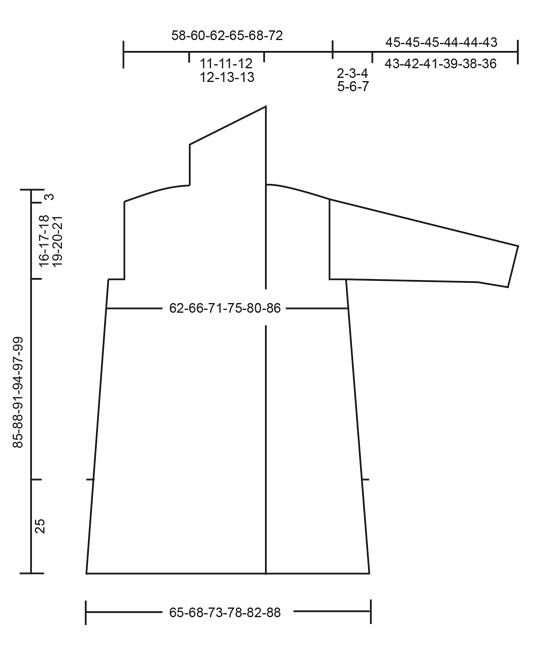
|
|
|
Have you made this or any other of our designs? Tag your pictures in social media with #dropsdesign so we can see them! Do you need help with this pattern?You'll find tutorial videos, a Comments/Questions area and more by visiting the pattern on garnstudio.com. © 1982-2024 DROPS Design A/S. We reserve all rights. This document, including all its sub-sections, has copyrights. Read more about what you can do with our patterns at the bottom of each pattern on our site. |
|









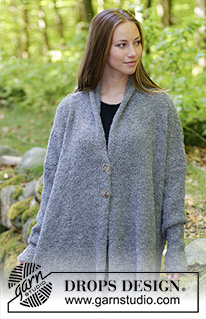
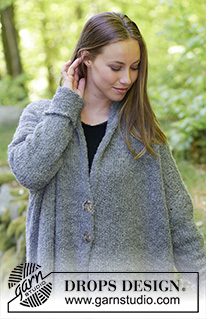


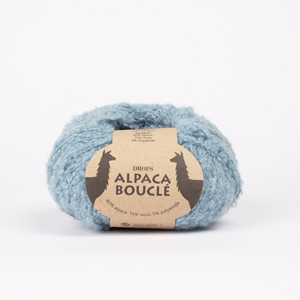
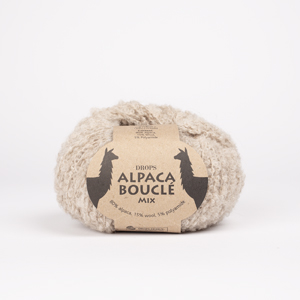




















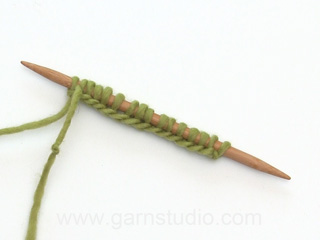





























Comments / Questions (2)
Klopt het dat voor het vest model Forest Mist maat S slechts 450 gram Alpaca Bouclé benodigd is, terwijl voor trui model Outlander ( 71 / 36) 550 gram garen nodig is? Hoe kan dit?
15.10.2018 - 13:20Bonjour je suis débutante et je ne sais pas si c'est adapté?
16.03.2018 - 11:53DROPS Design answered:
Bonjour Mme Bauer, lisez attentivement les explications, consultez nos vidéos pour comprendre les différentes techniques et n'hésitez pas à poser vos questions ici si besoin. Votre magasin saura également vous apporter toute assistance complémentaire. Bon tricot!
16.03.2018 - 14:14